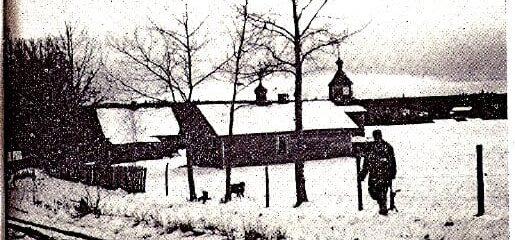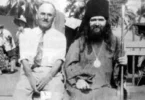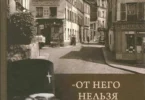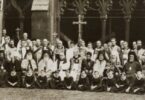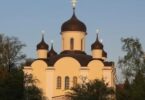Part IV, Chapter 1.5
The Dioceses in Canada
The Orthodox communities in Canada were at first subject to the ruling bishop of Alaska & North America. After the creation of two vicariates – Brooklyn and Alaska – in 1904 for the North American Diocese, an Orthodox mission was established a year later in Canada. The Canadian communities were thereby granted a certain degree of self-administration. The head of the mission was Archimandrite Alexander (Nemolovsky), who was appointed administrator of the Canadian communities. He headed the mission from 1905-09. Also, after his appointment and consecration as Bishop of Alaska, he remained administrator of the Canadian communities. It was not until 1914 that Archimandrite Amphilochius (Vokulsky) was appointed the new administrator of the Canadian mission. [1] Seraphim, Church Unity, pp. 24-25; Russ. Prav. Ts., 2, p. 806.
The real reason for establishing a mission was, however, that in Canada many communities were composed of immigrants from the Western Ukraine (e.g., Volynia and Bukovina), the greater majority of whom belonged to the Uniate Church. The mission’s goal was to return these people to Orthodoxy. Therefore, Hegumen Amphilocius of the Aleutian Mission was given this task and was simultaneously elevated to the rank of archimandrite. From 1901-1914, he had had great missionary success among the Alaskan and Aleutian population. [2] Church News (1940) 7, p. 40. The preconditions for a successful mission in Canada at this time were most favorable because there were no Uniate priests there, and the Roman Catholic priests who had parishes, which were mostly French or Polish, knew no Ukrainian. The use of Ukrainian in the divine services played such a significant role for the faithful, that in the 1930s, Bishop Joseph of Western Canada & Calgary complained that [the use of] Ukrainian determined where the faithful would attend church. This was also the case in the 1950s, when Archimandrite Anthony (Medvedev) was the administrator of the diocese. [3] Otchet 5-go s’ezda, pp. 40-41. Adherence to the Ukrainian language was the reason that the Russian Orthodox Church experienced no particular missionary success among these communities. After Rome refused to dispatch Uniate priests, these communities declared themselves independent in 1918 and founded the “Ukrainian Greek Orthodox Church in Canada,” whose “Faith and dogma are identical to the various already-established Greek Orthodox Churches, and which holds to the Faith and dogma of the first Seven Councils of the Christian Church.” [4] Jahrbuch der Orthodoxie (1976/77) pp. 194-200, here p. 195.
With this resolution, those Uniates who had been with Rome “returned” to Orthodoxy. For the Russian Church, there was for a short time the possibility of receiving these faithful into its jurisdiction, because in 1918 the communities turned to Bishop Alexander (Nemolovsky) with the request that he be the temporary head of the Church, until “the Ukrainians had their own bishop.” Bishop Alexander agreed, as did his successor, Metropolitan Platon in 1921. Shortly before his return from America, however, Alexander declined the invitation on the grounds that the Ukrainians did not have the right to found their own Church and must join the Russian Church. [5] Ibid., p.195. Presumably, Alexander had decided this, because in the Soviet Union in 1919 a “Ukrainian Autocephalous Orthodox Church” had been founded, and he must have feared that the developments in Canada could follow suit. This danger indeed existed, as later developments showed. This new Church likewise rejected the Ukrainian Autocephalists. Until 1924, the Church was subject first to Metropolitan Herman (Germanos) of the Syrian Orthodox Church and then to Archbishop John (Teodorovich), who had emigrated from Ukraine. Through emigration, the Church grew until today there are four dioceses, three bishops, 260 communities in Canada and 15 in Australia, and more than 100,000 faithful. Based on these developments, the Russian Church in Canada may have passed up the chance to bring more than 100,000 faithful into Orthodoxy and its jurisdiction.
Of the total Canadian population in 1961, 239,766 (1.3%) and in 1971, 316,605 (1.5%) belonged to the Orthodox Church. The majority of the faithful are Ukrainians, of whom, in 1961, there were 473,337, and in 1971 there were 580,000 in the country. [6] Canada Yearbook (1978/1979), pp. 161-162. Also, 189,653 Uniates lived there in 1961 and 227,730 in 1971. The number of Russians living in Canada was given as follows: in 1951, 91,279; in 1961, 119,168; in 1971, 64,475. [7] Ibid., p. 161. The growth in the 1950s can be attributed to the arrival of émigrés from Europe, the Far East, and North Africa. Of those 64,475 Russians living there in 1971, 31,745 gave Russian as their mother tongue, of whom only 12,590 used Russian as their colloquial language in the family. In 1976, only 23,480 Russians still considered Russian to be their mother tongue. [8] Ibid., p. 162. These developments illustrate the powerful assimilation of the émigrés, which can be attributed to the fact that outside of a few larger centers in the provinces of eastern Canada, the Russian émigrés lived widely dispersed throughout the country, mostly as farmers in central and western Canada. Between 20,000 and 30,000 faithful belong to the Church Abroad at this time in Canada.
In 1916, Bishop Alexander was appointed Bishop of Canada, with his see in Winnipeg, Manitoba Province. Bishop Alexander never took up this post, because shortly thereafter he had to take over the rule of the North American Diocese, as Archbishop Eudocimus was traveling to the Council in Moscow. Only in 1922 was a bishop again consecrated for Canada: Bishop Adam (Philippovsky), who spent only a short time in the diocese, because in 1924 he succeeded Bishop Stephen, who had returned to the Unia. In accordance with Metropolitan Platon’s desire, Archimandrite Arsenius (Chagovtsov) was consecrated Bishop of Winnipeg, vicar bishop for Canada. A few weeks after his consecration, he joined Metropolitan Platon, who had broken with the Synod. [9] Nikon, Zhizneopisanie, 5, p. 272. The communities of the Church Abroad were then subject to Bishop Apollinarius, who became the head of the North American communities in 1927.
There are no precise figures as to the number of communities in Canada at this time. It is only known that 12 Canadian communities agreed with the decisions of the Detroit Council in 1924. These must have joined the Metropolia. A total of only 60 communities had rejected the Detroit Council; the Church Abroad could claim at the most a dozen or so communities in Canada.
After the renewed schism in 1947, the Church Abroad had 36 communities in Canada and another 32 in the U.S.A. [10] Prav. Rus’ (1949) 20, pp. 2-11. By 1953, another 12 communities had joined, [11] Ibid. (1953) 9, pp. 7-19. so that in the mid-1950s there must have been some 50 communities in Canada. Today, the Diocese still has 23 Russian communities, a Bulgarian one, a Macedonian-Bulgarian one, and a Romanian one. [12] Spisok (1989), pp. 16-18, 27. The loss of almost half the communities can be explained by the fact that the many small diaspora parishes in central and western Canada were lost to attrition as the communities died out. Also, a dozen communities joined the Patriarchate with Archbishop Panteleimon (Rudyk), which now has more than 22 churches and some 3500 faithful. [13] Yearbook of American and Canadian Churches (1978), p. 127.
The Church Abroad created a Canadian vicariate in 1934. Archimandrite Joasaph (Skorodumov) was consecrated Bishop of Montréal but resided in Calgary. [14] Nikon, Zhizneopisanie, 5, pp. 278-279. Until 1934, this was his title, but after 1934, he was named Archbishop of Edmonton & Western Canada. After reunification with the Metropolia, a second diocese was created in Canada, which included Montréal & Eastern Canada, headed by Bishop Hieronymus, who had been consecrated Bishop of Detroit in 1935. [15] Tserk. Zhizn´ (1936) 7, pp. 104-105. This diocesan structure of two dioceses remained in force until 1957.
Archbishop Joasaph ruled the Western Canadian Diocese from 1930 until 1950; he then became Bishop of Buenos Aires & Argentina. His successor was Archbishop Panteleimon (Rudyk), who, however, only took up his duties at the end of 1951. Archimandrite Anthony (Medvedev) took over the administration from 1950-52. Archbishop Panteleimon remained ruling bishop until 1954; his successor until 1957 was Bishop Vitalis (Ustinov). Thereafter, the diocese existed only as a vicariate. Bishop Sabbas (Sarachevich) directed it until 1971 when he retired. He died in 1973, and no successor was appointed.
The Diocese of Montréal & Eastern Canada was ruled by Bishop Hieronymus from 1936-47. His successor, from 1947-54, was Bishop Gregory (Boriskevich, after 1952 Archbishop), after which Archbishop Panteleimon ruled the diocese from 1954-57. In 1957, the Synod retired him. Since that time, the rule of the Diocese of Montréal & Canada has been in the hands of Archbishop Vitalis, who was represented in Edmonton by Bishop Sabbas between the years 1958-1971. [16] Russ. Prav. Ts., 2, pp. 806-808.
The administrative structure of the Canadian diocese reflects the life of the Orthodox communities in Canada. Until the end of World War II, most communities were located in Western Canada. Thus, the first bishops all bore the title of the cities of Winnipeg, Calgary, or Edmonton in their designated positions. Most of the immigrants from eastern Europe had lived in the Canadian provinces of Manitoba, Saskatchewan, Alberta, and British Columbia since the turn of the century. Only after World War II did a move to eastern Canada occur, where today the largest communities are found in the Provinces of Québec and Ontario.
Bishop Joasaph resided in Calgary, where in 1930 a small community of 20-30 people existed. [17] Ibid., p. 821; Otchet 5-go s’ezda, p. 41. They succeeded in building a small wooden church in honor of All Saints, which simultaneously became the cathedral. This also had a small dwelling attached for Bishop Joasaph. The church was replaced by a new building, with a parish hall and a residence for the priest. Since then, the parish has had some 200 parishioners. [18] Russ. Prav. Ts., 2:, pp. 821-823. In 1938, Bishop Joasaph moved his residence to Edmonton, where the Russian community had obtained a former Protestant church. The church was consecrated in honor of St. Vladimir and served as the cathedral church for Edmonton & Western Canada. The parish house on the land was turned into a metochion and was to have been for a proposed monastic brotherhood. The most noteworthy thing about this cathedral was that no parish belonged to it. The community was comprised of some 30 people from the environs of the city. These were mainly Orthodox farmers of Ukrainian descent, who had rejected a Ukrainian Orthodox Church and traditionally felt connected to the Russian Orthodox Church. [19] Otchet 5-go s’ezda, p. 40.
By the establishment of a monastery in his diocese, Bishop Joasaph hoped to create a spiritual and theological center for the Church Abroad, which should have become the departure point for a mission among the Uniates and Orthodox Ukrainians in the diocese. [20] Arkhiepiskop Ioasaf v vospominaniyakh, p. 38. The hierarch made the first attempt in 1936-37 when he founded a small monastery 100 miles north of Edmonton called St. Sergius Hermitage. The bishop largely drew up the plans himself, intending it to be a summer residence. The Hermitage had 80 acres of land, a small chapel, and a frame house with cells for eight to ten monks. [21] Church News (1940) 9, pp. 53-56; 10, p. 55. In 1938, Bishop Joasaph made a further similar attempt some 120 miles northeast of Edmonton. This was the St. Seraphim Monastery at Good Fishlake, a fish-rich lake in the middle of a wooded region. On the land belonging to the monastery, a cemetery was also supposed to be established, where Bishop Joasaph wanted to be buried. Both attempts failed, however, because no monks could be found for a monastic community. [22] Prav. Rus´ (1952) 6, p. 13; The Orthodox Word (1968), pp. 85-87.
The desire to establish a monastery was finally to be fulfilled in the last years of his office. In 1948, monks from Europe and the Far East came to Canada, who began the building of the Holy Protection Skete, in Bluffton, in 1949. Three monks belonged to the Brotherhood. When, in 1951, nuns arrived from the Shanghai Convent of the Vladimir Icon of the Theotokos, the monks turned the monastery over to them. The monks moved into the metochion in Edmonton. [23] Otchet 5-go s’ezda, pp. 40-41.
The Holy Protection Convent has existed since 1952. Since then, some six to eight nuns have resided there, living off their farmland and the financial support of their mother convent. [24] Seide, Klöster im Ausland. For the monks formerly of the Holy Protection Skete, a plot of land near Bluffton (near Bellis) was purchased, and a skete in honor of St. Nicholas was established, attached to which is an additional 10 acres of farmland and another 130 acres of forest. Archimandrite Anthony consecrated the skete in 1952. Hegumen Ambrose directed the Skete until the 1960s. Today it remains unoccupied. In the small church divine services are occasionally celebrated. [25] Russ. Prav. Ts. 2, pp. 851-853.
Together with Bishop Vitalis, the new Bishop of Edmonton & Western Canada, seven monks came from Brazil, who belonged to the St. Job Brotherhood of Bishop Vitalis. The Brotherhood had been formed in Germany in 1947 by Archimandrite Vitalis, and in 1955 consisted of 12 people. Now the realization of the desire to establish a monastery in Canada seemed to have come much closer. In the environs of Northville (Province of Alberta), the Brotherhood purchased a plot of land and began building a monastery. Within a short space of time, a small church and main building with monastic cells were completed. This hopeful new beginning was again endangered two years later because Bishop Vitalis was named Archbishop and took over the rule of the Diocese of Montréal & Canada. In the Dormition Skete at Northville, only two monks remained behind; the rest accompanied him to Montréal. Hieromonk Seraphim (Philimonov) took over the direction of the skete and is still there. [26] Ibid., p. 854.
Presently, of the monasteries and sketes in western Canada, only the Holy Protection Convent and the Dormition Skete remain. The rest were closed in the 1950s.
When, in the 1950s, other Russian émigrés from Europe, the Far East, and North Africa came to Canada, many of them found work in the coal mines of western Canada. The majority of new Russian émigrés joined the Church Abroad, so that for the first time there was an increase in larger communities. In Vancouver and Edmonton, there are two parishes, and there are also parishes in Calgary, Edson, Northville, Wildwood, and other cities. Many of the old wooden churches were, over the course of time, replaced by brick or stone churches. [27] Ibid., pp. 820-846. The willingness of the faithful to donate money to the Church made it possible also for average and smaller communities to build new houses of worship. Thus, for example, the community of only 70 people in Calgary collected $25,000 to build a new church, the total cost of which amounted to $40,000. [28] Pravoslavny vestnik v Kanade (1964) 7, p. 8.
The care of the faithful in western Canada has always been problematic because the communities are spread so far apart, and many people live in rural areas. On average, city parishes have around 100 members. Many communities have fewer. Thus, the clergy often had to care for more than one community, because the smaller ones did not have sufficient financial means to support their own priest. During its existence, the diocese always received financial subsidies from other North American dioceses, which had larger revenues. [29] Otchet 5-go s’ezda, p. 44. After the renewed schism of 1947, the Church Abroad established its own Diocese of Eastern Canada, with Montréal as the bishop’s residence. Whereas, before World War II, the eastern Canadian communities were mostly very small, today the most numerically significant communities are found there. One of the oldest communities on Canadian soil is in the Diocese of Eastern Canada. It is the community in Lachine (Province of Québec), which was founded in 1911.
Besides Russians, also Orthodox Romanians, Poles, Slovaks, Carpatho-Russians, Greeks, and other nationalities belong to this community.
The cities of Montréal and Toronto are the centers in eastern Canada. Besides Russian parishes, the Church Abroad has also a Romanian one in Montréal, a Bulgarian one in Willmot (near Niagara Falls), and a Bulgarian-Macedonian one in Toronto.
In 1957, both Canadian dioceses were merged, and Archbishop Vitalis (Ustinov) took over the rule of the diocese.
In 1970, Archbishop Vitalis had a vicar bishop in Edmonton, three archimandrites, two hegumens, seven archpriests, eight priests, four hieromonks, and two hierodeacons. [30] Pravoslavny vestnik v Kanade (1970) 3, p. 2. In many of the dioceses of the Church Abroad in the 1970s, the number of priests was decreasing due to old age; but by the early 1980s, there were thirty clergymen for 23 Church Abroad parishes [31] Spisok (1989) pp. 16-18. in Canada although they also occasionally dispatched clergy to other dioceses in order to alleviate the shortage of priests. Among these were, for example, Archbishop Paul of Australia, who had been a member of the St. Job Brotherhood and administered the Diocese of Southern Germany, and Archimandrite Theodore (Galitzine), who looked after the communities in southern Germany.
The material situation of the Canadian Diocese is decidedly good. The Church headquarters in New York receives regular financial subsidies from Montréal to take care of its diverse tasks. The administrative and spiritual center of the diocese is Montréal. The Cathedral of St. Nicholas is there; it was consecrated in 1964 and is located in a large building complex in the city center. The total price of the plot was to have been $180,000 but was subsequently reduced to $130,000 because the building was in need of repair. The plot with the old cathedral, which in the meantime had become dilapidated, was sold to the city for $100,000 so that the new cathedral and a large adjacent building could be paid for in short order. [32] Pravoslavny vestnik v Kanade (1964) 4, p. 7; 7, p. 6.
The church’s iconostasis consists of three tiers of icons, which total 115 in number. [33] Ibid. (1972) 18-19, Supplement with unnumbered pages. The church utensils and liturgical books come from the old cathedral. In a side part of the building is the parish center, which includes a spacious hall for meetings, a library with a bookshop, a parish school, and so on. Next to the cathedral lies a second building with forty rooms. In this house is the archbishop’s residence, a residence for the St. Job Brotherhood, a chapel in honor of St. Seraphim of Sarov, the diocesan offices, and a small printing press and publishing house. The press has been producing the periodical Orthodox Messenger in Canada (Pravoslavny Vestnik v Kanade) since 1961. Since 1964, this has appeared in printed form with approximately 12 pages per issue and 12 issues per year.
From time to time, a few nuns have also lived at the cathedral in addition to the St. Job Brotherhood. The former, together with the lay sisterhood named in honor of St. Olga, undertook to work with the young and elderly. There were as many as seven nuns and twenty women in the lay sisterhood. Among the nuns were four very aged and invalid sisters from Harbin, whom the Communist authorities had allowed to leave China in the late 1950s. [34] Ibid. (1962) 7, p. 8. Mother Theodosia (Baranova, later Abbess of the Mt. of Olives Convent in Palestine) took over the direction of the sisterhood.
For the monks of the St. Job Brotherhood who had come to Montréal from Edmonton with Metropolitan Vitalis, a skete named in honor of Christ’s Transfiguration was built on the Canadian-U.S. border in the early 1960s. [35] Russ. Prav. Ts. 2, pp. 818-819. This monastery has a church, consecrated in 1976, several houses with cells for monks and guests, a candle works, a printing press, a Russian cemetery, a small farm, and extensive woodlands. The skete is only occupied in the summer, for the Brotherhood winters in Montréal. [36] Seide, Klöster im Ausland.
The Brotherhood’s printing press and publishing house is of special significance to the Church Abroad in general, as well as to the Canadian diocese. Since 1947-48, the Brotherhood has also published the journal Orthodox Observer (Pravoslavnoe Obozrenie), which has enjoyed wide distribution. In 1972, the Brotherhood began publishing an English-language periodical The True Vine, the publication of which had, however, to be suspended. The publishing house has also produced many books in addition to periodicals, e.g. the two-volume edition of Archpriest George Grabbe’s The Church & Its Teaching in Life (Tserkov i eya uchenie v zhizni) (1964 and 1970), a bilingual (Russian/English) anniversary album in commemoration of the 50th anniversary of the founding of the Russian Church Abroad, and numerous smaller books and writings.
The Herald reports on diocesan life and the individual Canadian parishes, as well as the life of the Church Abroad. It also regularly publishes the budget of individual parishes, including the Montreal cathedral, whose budget in the 1960s was approximately $30-35,000. Income exceeded expenditures by $25,000. Income was derived primarily from the sale of candles (ca. $8,000) and from donations (approximately $10,000), the remainder coming from other sources. The main expenditures were at $7,800 for the support of the clergy and another $2,000 for candle supplies. After the money owed on the cathedral and the adjacent building was repaid, the parish had a profit of $5,000-$10,000 annually. In the mid-1970s the profit amounted to $50,000. [37] Pravoslavny vestnik v Kanade (1964) 3, p. 5; (1970) 1, p. 10; (1975) 2, p. 13. The journal also published the budgets of smaller communities from time to time. Thus, the parish in Vancouver had an income of $5,700, in contrast to its expenditures of $7,000. The parish in Winnipeg had an income of $6,900, and expenditures of $6,800. Both statistics came from the year 1970. [38] Ibid., (1971) 8, p. 12; 10, P. 8; (1974) 8-9, p. 16.
The development of this blossoming church life is largely thanks to the labors of Archbishop Vitalis. For his work, he was awarded a jeweled cross for his klobuk in 1971; and in 1976, he was named the second deputy to Metropolitan Philaret. Due to his excellent knowledge of French (he had attended the French Lycée in Lemain, near Paris), he was able to maintain positive contact with the authorities in the French-speaking province of Québec and with the local populace. Through lectures and publications in Russian, French, and English, he did much to awaken and gain an understanding of the Church Abroad.
References
| ↵1 | Seraphim, Church Unity, pp. 24-25; Russ. Prav. Ts., 2, p. 806. |
|---|---|
| ↵2 | Church News (1940) 7, p. 40. |
| ↵3 | Otchet 5-go s’ezda, pp. 40-41. |
| ↵4 | Jahrbuch der Orthodoxie (1976/77) pp. 194-200, here p. 195. |
| ↵5 | Ibid., p.195. |
| ↵6 | Canada Yearbook (1978/1979), pp. 161-162. Also, 189,653 Uniates lived there in 1961 and 227,730 in 1971. |
| ↵7 | Ibid., p. 161. |
| ↵8 | Ibid., p. 162. |
| ↵9 | Nikon, Zhizneopisanie, 5, p. 272. |
| ↵10 | Prav. Rus’ (1949) 20, pp. 2-11. |
| ↵11 | Ibid. (1953) 9, pp. 7-19. |
| ↵12 | Spisok (1989), pp. 16-18, 27. |
| ↵13 | Yearbook of American and Canadian Churches (1978), p. 127. |
| ↵14 | Nikon, Zhizneopisanie, 5, pp. 278-279. |
| ↵15 | Tserk. Zhizn´ (1936) 7, pp. 104-105. |
| ↵16 | Russ. Prav. Ts., 2, pp. 806-808. |
| ↵17 | Ibid., p. 821; Otchet 5-go s’ezda, p. 41. |
| ↵18 | Russ. Prav. Ts., 2:, pp. 821-823. |
| ↵19 | Otchet 5-go s’ezda, p. 40. |
| ↵20 | Arkhiepiskop Ioasaf v vospominaniyakh, p. 38. |
| ↵21 | Church News (1940) 9, pp. 53-56; 10, p. 55. |
| ↵22 | Prav. Rus´ (1952) 6, p. 13; The Orthodox Word (1968), pp. 85-87. |
| ↵23 | Otchet 5-go s’ezda, pp. 40-41. |
| ↵24 | Seide, Klöster im Ausland. |
| ↵25 | Russ. Prav. Ts. 2, pp. 851-853. |
| ↵26 | Ibid., p. 854. |
| ↵27 | Ibid., pp. 820-846. |
| ↵28 | Pravoslavny vestnik v Kanade (1964) 7, p. 8. |
| ↵29 | Otchet 5-go s’ezda, p. 44. |
| ↵30 | Pravoslavny vestnik v Kanade (1970) 3, p. 2. |
| ↵31 | Spisok (1989) pp. 16-18. |
| ↵32 | Pravoslavny vestnik v Kanade (1964) 4, p. 7; 7, p. 6. |
| ↵33 | Ibid. (1972) 18-19, Supplement with unnumbered pages. |
| ↵34 | Ibid. (1962) 7, p. 8. |
| ↵35 | Russ. Prav. Ts. 2, pp. 818-819. |
| ↵36 | Seide, Klöster im Ausland. |
| ↵37 | Pravoslavny vestnik v Kanade (1964) 3, p. 5; (1970) 1, p. 10; (1975) 2, p. 13. |
| ↵38 | Ibid., (1971) 8, p. 12; 10, P. 8; (1974) 8-9, p. 16. |

